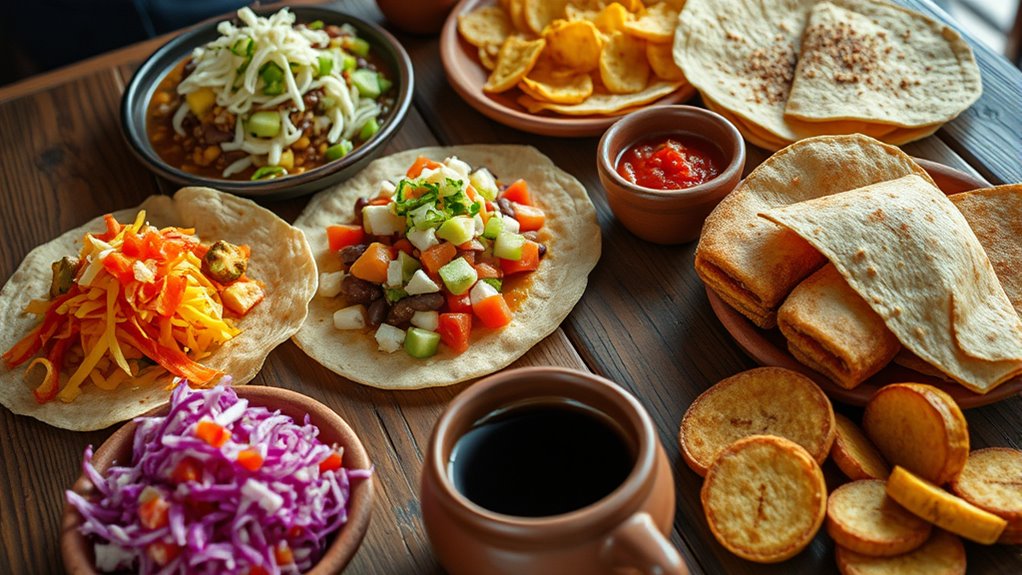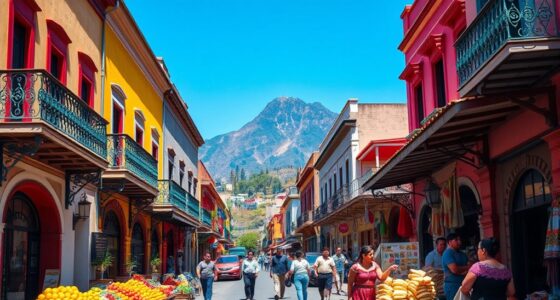El Salvador’s cuisine highlights native ingredients like corn, beans, pork, and seafood, prepared with traditional methods such as steaming in banana leaves and open-flame grilling. Popular dishes include pupusas, tamales, and hearty soups like Sopa de Res and Sopa de Gallina India, often served with vibrant salsas. Street foods and coastal seafood emphasize freshness and simplicity, all rooted in indigenous and colonial influences. Exploring further reveals the rich culinary heritage that makes Salvadoran food truly unique.
Key Takeaways
- Salvadoran cuisine centers on corn-based dishes like pupusas, tamales, and atol, using indigenous ingredients and traditional steaming techniques.
- Coastal regions emphasize fresh seafood, grilled or stewed, integrated with indigenous methods like steaming in banana leaves.
- Popular dishes include hearty soups such as Sopa de Pata and Sopa de Res, often served with fresh salsas like curtido and chimol.
- Street foods like grilled corn, fried pastries, and pupusas are vital, reflecting local tastes and preserving culinary heritage.
- Food plays a key cultural role during festivals and celebrations, symbolizing national pride and community identity through traditional recipes and techniques.
The Heart of Salvadoran Cuisine: Staples and Ingredients
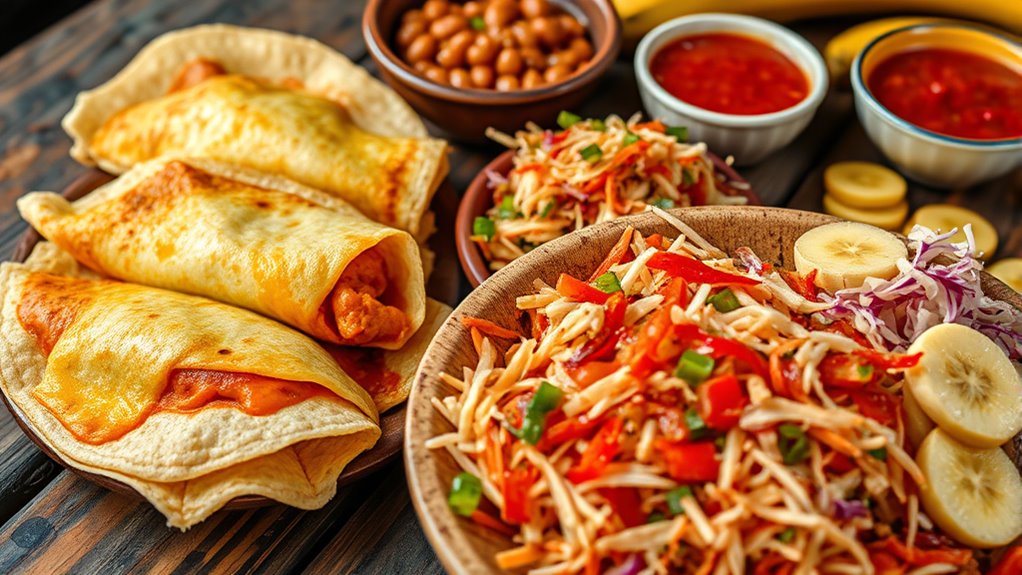
At the core of Salvadoran cuisine are simple yet essential ingredients that define its character, with corn, beans, and rice serving as the foundational staples. Corn is everywhere—used in tortillas, tamales, and drinks like *atol de elote*. Beans, especially refried red or black beans, accompany almost every meal, providing richness and nutrition. Rice acts as a neutral side, often cooked with beans in a dish called *casamiento*. You’ll also find native ingredients like *loroco* flower, which adds unique flavor to dishes like pupusas. Pork and chicken are common proteins, prepared through grilling, frying, or slow cooking. Fresh herbs, tomatoes, onions, and native fruits add vibrant flavors, making these ingredients versatile and central to Salvadoran cooking. Embracing traditional creative practices in cooking helps preserve these flavors and encourages innovation within culinary traditions.
Traditional Dishes That Define Salvadoran Food Culture

Traditional Salvadoran dishes are the heart of its culinary identity, showcasing a harmonious blend of indigenous ingredients and colonial influences. You’ll find staples like pupusas, with their thick corn tortillas filled with cheese, beans, or pork, often served with curtido and salsa roja. Tamales wrapped in banana leaves and churrasco, grilled beef seasoned with local spices, also define the cuisine. These dishes reflect the country’s rich history and local flavors. To keep you engaged, here’s a quick overview:
| Dish | Main Ingredients | Celebratory Occasions |
|---|---|---|
| Pupusas | Corn, cheese, pork | National Day, festivals |
| Tamales | Cornmeal, meat, leaves | Christmas, family gatherings |
| Churrasco | Beef, spices, vegetables | Sundays, special events |
These foods symbolize Salvadoran pride and tradition. Culinary traditions play a vital role in preserving the country’s cultural heritage.
Indigenous and Colonial Influences Shaping Flavors

You can see how Salvadoran flavors blend indigenous ingredients like corn, beans, and native flowers with Spanish colonial spices and techniques. This fusion creates a rich culinary heritage that balances traditional methods with new influences. By exploring these roots, you’ll better understand the unique tastes that define Salvadoran cuisine today.
Indigenous Ingredients and Techniques
Indigenous ingredients and techniques form the foundation of Salvadoran cuisine, shaping its distinctive flavors and cooking methods. Corn is central, used in tortillas, tamales, and drinks like *atol de elote*. Beans and rice often combine into dishes like *casamiento*, adding hearty textures. Edible native flowers such as *loroco* contribute unique, aromatic notes to various recipes. Traditional cooking methods include steaming foods in banana or plantain leaves, a technique preserved from indigenous practices. Frying cassava (*yuca*) and pork rinds (*chicharrón*) showcase indigenous flavors, while slow simmering soups like *sopa de pata* reflect a deep-rooted use of local ingredients. Cooking techniques like open-flame grilling are also part of traditional Salvadoran food preparation. These techniques and ingredients create a vibrant, authentic culinary identity that honors El Salvador’s indigenous heritage.
Spanish Colonial Culinary Legacy
- Integration of Spanish baking techniques and sweet desserts
- Use of banana and plantain leaves for steaming and wrapping
- Adoption of European-style stews and grilled meats
- Incorporation of native ingredients like loroco and local spices
- The tradition of using diverse designs in kitchenware and cookware reflects the vibrant cultural fusion in Salvadoran cuisine.
Popular Soups and Stews: Hearty and Rich Flavors
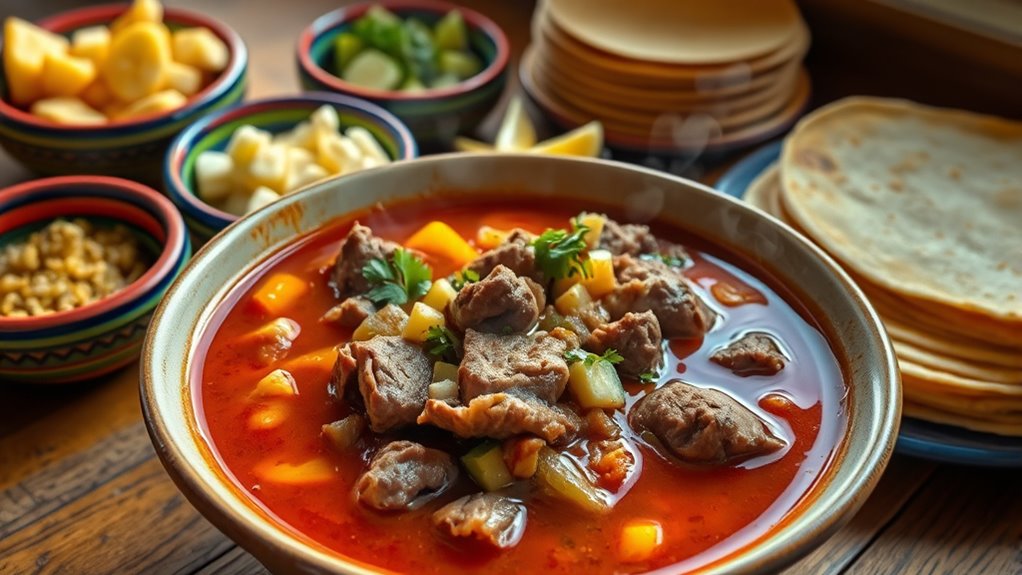
Salvadoran soups and stews are known for their hearty, robust flavors that reflect the country’s rich culinary heritage. You’ll find these dishes packed with local ingredients like corn, beef, pork, and vegetables, simmered to develop deep, satisfying tastes. Sopa de Pata, made from cow’s feet, offers a gelatinous, nourishing broth, while Sopa de Res features tender beef with vegetables in a comforting soup. Sopa de Mondongo combines tripe with spices for an intense flavor, and Sopa de Gallina India uses native hen for a rich, savory broth. These dishes often include fresh salsas like *chimol* or *curtido*, adding tartness to balance the richness. Whether enjoyed daily or during festivities, these soups showcase Salvadoran resilience and love for bold, filling flavors. Incorporating traditional cooking techniques and authentic ingredients enhances their culinary authenticity, which is a hallmark of Salvadoran cuisine.
Street Food Delights and Snack Favorites

Street food and snacks are essential parts of El Salvador’s vibrant culinary scene, offering quick, flavorful bites that reflect local tastes and traditions. When you explore the streets, you’ll find a variety of treats that showcase bold flavors and cultural influences. These foods are affordable, convenient, and perfect for socializing or grabbing a quick meal. From grilled corn topped with spices to fried pastries filled with savory or sweet fillings, Salvadoran street snacks are full of character. They often incorporate native ingredients like corn, pork, and native flowers, highlighting indigenous roots with a spicy and fresh twist. Whether you’re snacking on a warm empanada or enjoying a colorful elote, these delights provide a true taste of Salvadoran street life. Additionally, the use of colorful presentation in street food enhances visual appeal and attracts more local and tourist customers.
Celebratory Foods and Festive Culinary Traditions
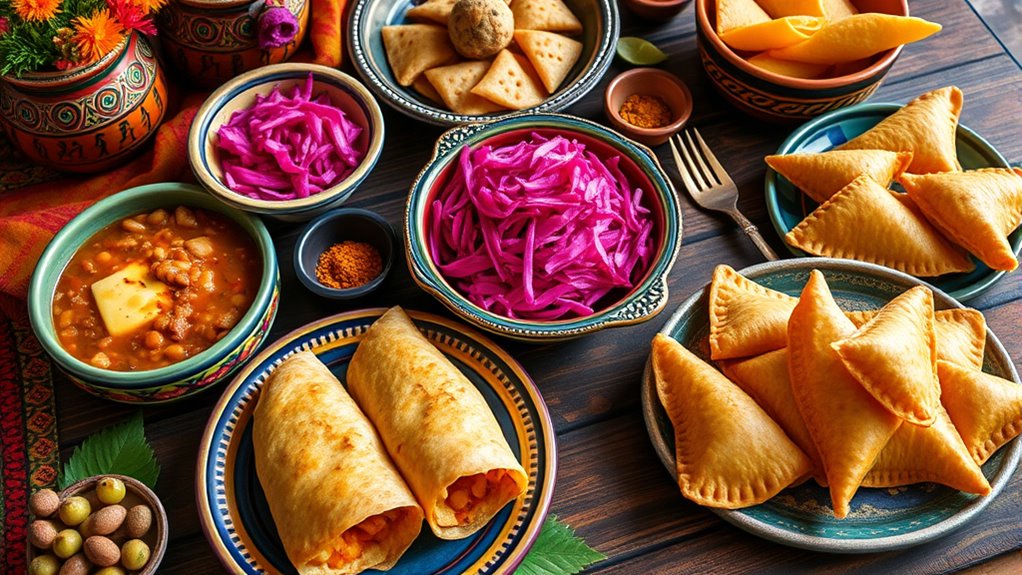
Festive occasions and family gatherings in El Salvador are lively moments where traditional foods take center stage. During celebrations like Christmas, Independence Day, and local festivals, you’ll find dishes that showcase cultural pride. Tamales, wrapped in banana or plantain leaves, are often prepared in large batches, symbolizing unity and tradition. Pupusas, especially on National Pupusa Day, become a centerpiece, highlighting the country’s culinary identity. Roasted pork (*lechón*) and turkey (*pavo*) are common on holiday tables, often accompanied by rice, beans, and vibrant salsas. Desserts like *nuegados* and *torrejas* add sweetness to festivities. These foods aren’t just about nourishment—they embody community, history, and national pride, bringing people together to celebrate El Salvador’s rich culinary heritage. Incorporating traditional serving methods enhances the cultural experience and preserves culinary customs.
The Art of Preparing Pupusas: National Pride on a Plate
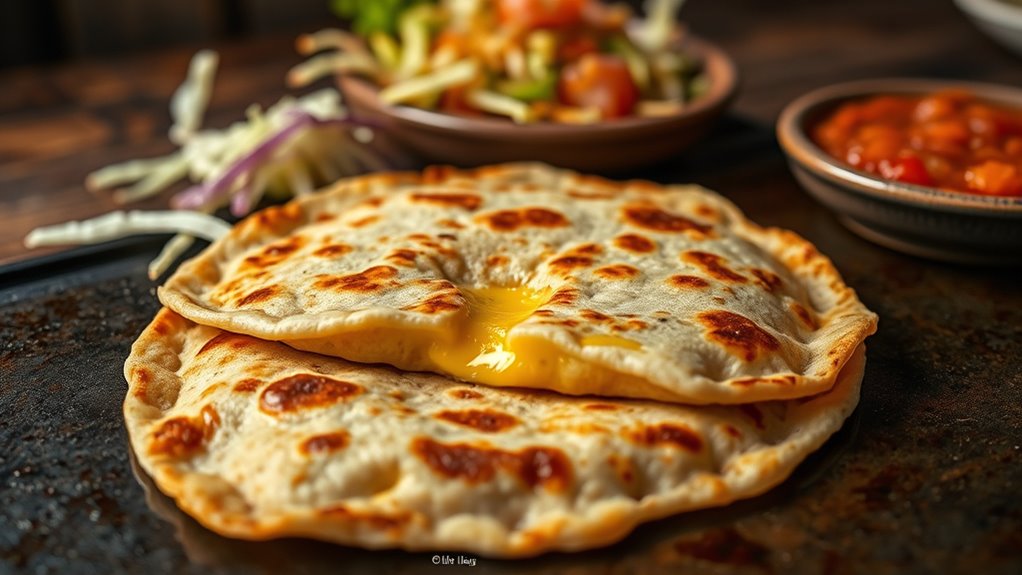
Making pupusas is an art that combines tradition, skill, and pride, reflecting El Salvador’s rich culinary heritage. You start with masa de maíz, kneading it until smooth, then shaping it into small, thick discs. Next, you fill each disc with ingredients like quesillo, refried beans, pork, or loroco, sealing the edges carefully. Cooking involves grilling or frying the pupusas until golden and crispy on the outside. Serving them hot with curtido and salsa roja completes the experience. Your mastery lies in balancing the dough’s thickness, filling richness, and cooking time. This process showcases Salvadoran craftsmanship and cultural pride, making each pupusa a delicious symbol of national identity. Mastering the traditional cooking techniques is essential to achieving the ideal texture and flavor.
Unique Cooking Techniques and Food Presentation
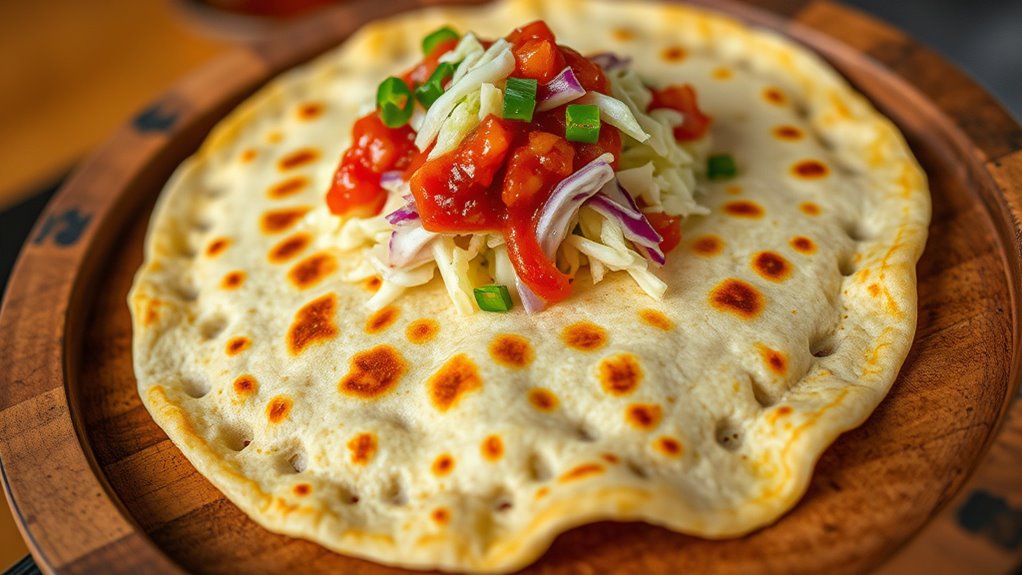
Salvadoran cuisine employs a variety of distinctive cooking techniques that highlight the country’s rich culinary heritage. You’ll find steaming methods using banana or plantain leaves, which lock in flavors and keep dishes moist—perfect for tamales and pasteles. Grilling is common for meats like churrasco, giving them a smoky, charred aroma that enhances flavor. Frying is also prevalent, especially for street foods like yuca frita and nuegados, creating crispy textures. Presentation often emphasizes vibrant colors and rustic styles, such as serving pupusas topped with fresh curtido and salsa roja on banana leaves or clay plates. You’ll notice that traditional dishes are designed to be both visually appealing and practical, reflecting a culture that values lively, communal eating experiences. Additionally, eye patch benefits are sometimes incorporated into wellness routines to maintain a fresh appearance after indulging in flavorful, hearty meals.
The Role of Seafood in Coastal Culinary Practices
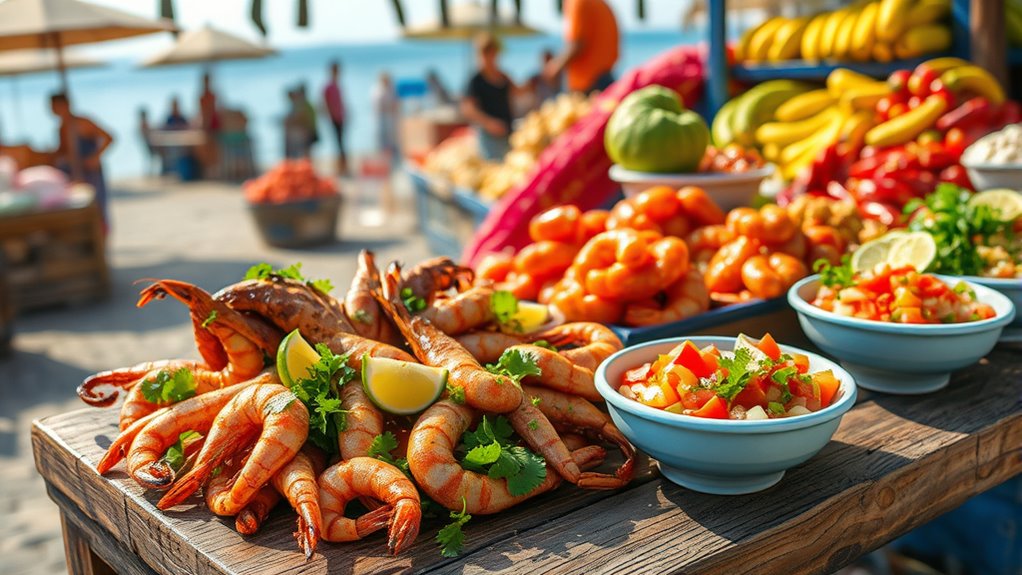
Coastal regions of El Salvador have cultivated a vibrant seafood tradition that reflects the country’s proximity to the Pacific Ocean. You’ll find that seafood plays an essential role in local dishes, showcasing fresh catches and bold flavors. Fish, shrimp, and clams are common ingredients, often grilled, stewed, or incorporated into soups. Coastal culinary practices emphasize simple, flavorful preparations that highlight the ocean’s bounty. You might enjoy dishes like seafood stews or ceviche with citrus and spices. The use of banana leaves for steaming seafood preserves moisture and adds aroma. Street vendors frequently serve quick seafood snacks, making fresh fish accessible and integral to daily life. Recognizing the role of seafood in coastal communities helps explain the prominence of these culinary traditions.
Preserving Culinary Heritage Through Recipes and Practices
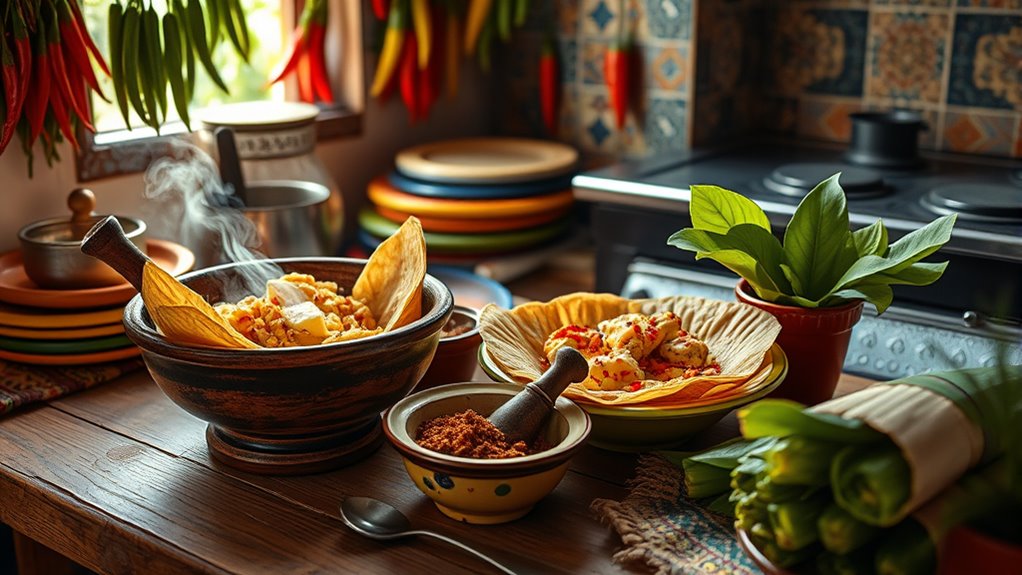
Preserving El Salvador’s culinary heritage relies on passing down traditional recipes and practices that embody the country’s indigenous roots and colonial influences. You can do this by learning family recipes for pupusas, tamales, and soups, which often remain unchanged for generations. Practice cooking with native ingredients like corn, beans, and native flowers such as loroco, maintaining authentic preparation techniques like steaming in banana leaves or grilling over open flames. Share these methods with others and participate in cultural celebrations like National Pupusa Day, reinforcing community bonds. Documenting recipes and storytelling helps keep traditions alive amid modern influences. By actively engaging in these practices, you ensure that Salvadoran culinary identity endures, honoring its rich history and diverse cultural tapestry.
Frequently Asked Questions
How Do Indigenous Ingredients Influence Modern Salvadoran Dishes?
You see indigenous ingredients like corn, beans, and native flowers deeply shaping Salvadoran dishes today. They form the base for staples like pupusas, tamales, and yuca con chicharrón, blending traditional flavors with modern recipes. You’ll notice the use of banana and plantain leaves for steaming, and fresh, local herbs that add authentic, earthy tastes. These ingredients preserve indigenous roots while enriching contemporary Salvadoran cuisine with vibrant, flavorful dishes.
What Are Traditional Methods for Preparing and Serving Tamales?
You prepare tamales by mixing cornmeal dough with fillings like meat, beans, or vegetables. Then, you wrap the mixture in banana or plantain leaves, sealing them tightly. You steam the wrapped tamales over boiling water until fully cooked, which locks in flavors and moisture. Finally, you serve them hot, often with salsa or curtido, enjoying the tender, savory results of this traditional method.
How Do Colonial Influences Shape Salvadoran Street Food?
Colonial influences craft colorful, creative street foods, blending bold European techniques with native ingredients. You’ll notice baked breads like panes rellenos, stuffed with savory fillings, showcasing Spanish-inspired baking. You might also spot sweet treats like torrejas, transformed from European bread pudding, fried and finished with fragrant cinnamon. These fusion foods foster festive flavors, fueling community gatherings and fostering cultural continuity, all while adding a delightful dash of colonial charm to Salvadoran street scenes.
What Is the Significance of Pupusas in Salvadoran Culture?
You should know that pupusas hold deep cultural significance in El Salvador because they represent national pride and community. As you enjoy a pupusa, you’re partaking in a tradition rooted in indigenous Pipil roots, celebrating history and identity. They’re more than just food; they’re a symbol of resilience, unity, and cultural expression, especially during festivities like Pupusa Day, where locals gather to honor this beloved dish.
How Are Seafood Flavors Incorporated Into Coastal Salvadoran Cuisine?
Seafood flavors are woven into coastal Salvadoran cuisine like vibrant threads in a tapestry. You’ll find dishes like *mariscada* (seafood stew) packed with fresh shrimp, clams, and fish, highlighting the ocean’s bounty. Grilled fish with tangy citrus or spicy sauces also showcase coastal flavors. The use of local seafood reflects the region’s connection to the sea, offering bold, fresh tastes that bring the ocean right to your plate.
Conclusion
You can truly taste El Salvador’s rich history and vibrant culture in every bite. It’s believed that traditional recipes have been passed down through generations, preserving indigenous and colonial influences. By exploring these flavors, you connect with a community that values its culinary heritage. So, next time you enjoy a pupusa or a hearty stew, remember — you’re experiencing a living history, a delicious affirmation to El Salvador’s enduring culinary soul.

